|
CHANGJIN JOURNAL 05.01.03
IN THIS ISSUE we continue our
series on the breakout from Hagaru‐ri to the coast where the units of X Corps are
busy preparing the Hungnam Perimeter. This presents the breakout from Koto‐ri to
the Funchilin Pass, with emphasis on the organization and operations of the Army
"Provisional Battalion" that is seldom covered in contemporary literature
about the Chosin campaign. In this coverage we will use extracts from Major General O.P.
Smith's "Aide Memoire" to highlight the Marine version of the story, then
later discuss the differences.
BREAKOUT FROM KOTO
BACKGROUND
Koto‐ri developed into one of the key
bastions of the 1MarDiv between the coast and the reservoir area. As of the night of 27
November when the CCF cut the road to Hagaru this became the Headquarters of Colonel
Puller's 1st Marine Regiment with the 2/1 Marines providing the perimeter force
until arrival of additional units. This was an interesting location, a small village
located four kilometers north of the pass and 11 miles south of Hagaru. One other road,
more like an improved trail, extended west to the hamlet of Hamadae‐ri, and from
there through the rugged mountains laden with switchbacks and villages supporting mining
operations, eventually arriving at the road between Sachang‐ni (1/7 Infantry,
3ID) and Yudam‐ni 30 miles to the north. A map study reveals this as hardly a
good route for deep envelopment by large forces.
Units at Koto began
to increase with the arrival of the 185th Engineer Bn on 28 November, a unit destined
for Hagaru where its attached D/10th Engineers was already located. That mission was
aborted when the 185th was assigned a sector of the Koto perimeter in a defensive role,
being reinforced by one platoon of the 44th Engineer Construction Bn. On 3 December the
battalion began construction of the Koto airstrip which was used by light aircraft, on 6
December by Navy TFBs and on 8‐9 December by C‐47s. A gift to the coming
engineer effort was the arrival of two 6‐ton Brockway bridge trucks of the 58th
Treadway Bridge Company with an attached platoon of the 512th Engineer Dump Truck
Company, units that at the time were hauling building materials for the Corps Advance CP
to be built at Hagaru. The supplies were quickly unloaded and put to use expanding
billeting and medical facilities for the expanding Koto perimeter, a great help to the
breakout force from Hagaru.
What was an advance CP of X Corps doing
way up here in the boonies north of the Funchilin Pass, a major MSR problem that
struggled to handle logistic support of one division? Was this General Almond's
nudge to get General Smith moving?
On 1 December the 2/31, the third
of Colonel MacLean's RCT 31 three infantry battalions arrived, after which F2/31
attacked and took the critical Hill 1328 which became part of the Koto perimeter, later
occupied by G2/31 until the withdrawal. Many 1MarDiv service and supply units, armor and
British Royal Marines, continued to arrive until the gatehouse bridge was finally
damaged beyond repair on 5 December.
8 DECEMBER ‐
KOTO TO THE PASS
The breakout plan from Koto south considered
the rugged terrain of the pass within which was the most important objective, the blown
bridge at the gatehouse. The approach included mountain ridges on both sides of the road
which had to be secured to protect the motorized column that would later uncoil from the
Koto perimeter into one long train. Once in the pass the terrain opens to the right
(west) while the road gradually descends along the steep slopes on the left (east). From
the pass it was about two kilometers to the gatehouse. The mountain ridge on the left
side of the road reaches its highest point in the pass, then rapidly ascends to terrain
including the gatehouse.
MAP 1:50,000 KOTO TO CHINHUNG
Click on the map for a full‐screen image; use
your Back button to return to this text.
This is a copy of a 1951 map very similar to the Japanese map
used in 1950, with 20 meter contour lines to show the viewer the difficult
terrain of the Funchilin Pass.
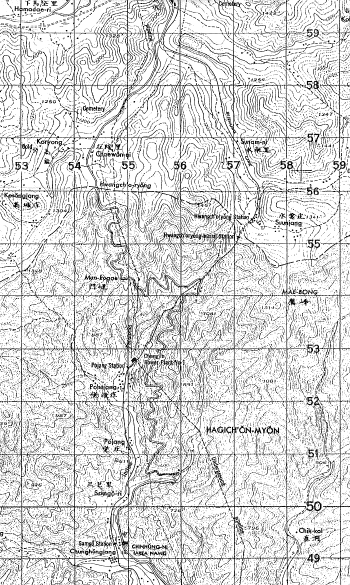
ENEMY
CONSIDERATIONS
It was known that the terrain west of the road was
critical. G Company 2/31 had been occupying the north end of that ridge at Hill 1328
where observers has seen columns of Chinese troops numbering inthousands marching
south, avoiding the perimeter at Koto as they moved to positions in their attempt to
stop the breakout. It was also known that the Chinese had been suffering from the
cold and were running low on supplies. They were a long way from their source of
supply beyond the Yalu River. Based on these facts, the plan assumed the Chinese
defense to be the ridges on both sides of the road.
There is more
to consider, that is, the combat capabilities and staying power of the CCF. Chinese
divisions arrived in the Chosin area with weapons and supplies carried on the backs
of soldiers; they had no logistical system to back them up at the time. When the
attacking units at Yudam and east of Chosin were bloodied and ran out of ammunition,
they were replaced by back‐up units. As a result they dissipated their combat
power on both sides of the reservoir and during two major attacks on Hagaru. After
that the Chinese combat capability was limited to manning fireblocks (Roy
Appleman's term). After that they were no longer looking for a fight, only
remained in their blocking positions to expend the last of their ammunition as the
Americans and British swept them aside. This theory is reinforced by the fact that
Koto had never received a major attack, although it was known that thousands of
Chinese were seen bypassing that perimeter. This can result in only one conclusion:
the Chinese were waiting for the Tenth Corps forces to leave North Korea as they
harassed the departure with immobile fireblocks manned by Chinese soldiers who
suffered the ravages of severe cold and malnutrition.
The flanks
had to be secured to allow the Brockway trucks with Treadway bridge sections to
reach the pass and protect the motor column to follow. Although indications were
limited, enemy movements around the east side of Koto to the pass remained a
possibility because the narrow gauge railroad moved around that side of the mountain
to the cableway south of the gatehouse. All of these considerations were essential
in developing an intelligence estimate of the situation. What no one could predict
was the weather.
The Air Force with support of the Army Airborne
riggers had been busy making test drops of Treadway bridge sections. Eight sections
were dropped from C‐119 aircraft in a designated drop zone at Koto. One was
damaged and another landed in enemy territory; six were enough. Bridge platoon
leader Lt. Charles C. Ward and his men then loaded sections to Brockway trucks of
the 58th Bridge Company and awaited orders to move to the Funchilin Pass.
As you follow the description of the breakout, study this map with
overlays that show the breakout for 8 December. Keep distance in mind: from the Koto
perimeter to the top of the pass is 2500 meters, from there the road goes downhill
to the gatehouse. This entire area was within range of artillery units at Koto, also
within range of 155mm howitzers of the Army 92d AFA Bn at Chinhung‐ni, both
depending on observation and communication.
BREAKOUT FROM KOTO TO FUNCHILIN PASS
‐ 8 December
Click on the map for a
full‐screen image; use your Back button to return to this
text.
Map 13‐1A from the CHOSIN
CHRONOLOGY © George A. Rasula, 1992, 2003.
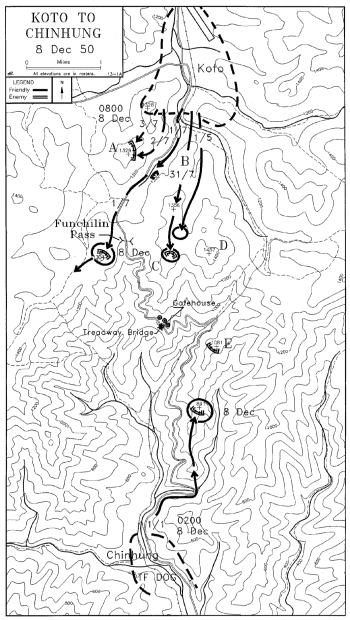
MAJOR GENERAL O.P. SMITH
AIDE‐MEMOIRE
Here we insert an extract from Major
General O.P. Smith's Aide‐Memoire which highlights the major actions of
the breakout as reported to him by commanders and staff. Later we will explain what
actually happened.
Operations on 8
December.
After a quiet night at
Koto‐ri, the attack of RCT‐7 jumped off as scheduled at 0800, 8
December, as did the attack of the 1/1 Marines from Chinhung‐ni. A
blinding snowstorm that continued most of the day precluded the use of air
support and hampered operations of the ground units. RCT‐7 employed its
3/7 in the attack to seize Objective A. It met strong enemy opposition from the
objective. The 2/7 Marines was moved forward to assist the 3/7 by attacking from
the flank. The 1/7 Marines moved south astride the MSR prepared to attack and
seize Objective C when the attack on Objective A had progressed sufficiently to
warrant it. The Provisional Battalion USA, attached to RCT‐7, attacked
and seized Objective B without opposition and was pushed forward by RCT‐7
to the high ground south of Objective B and northwest of Objective D. From these
positions the Provisional Battalion was directed to send patrols forward to a
distance of 800 yards.
RCT‐5,
employing its 1/5, launched its attack on Objective D at 1200 and by 1425 had seized
it against light opposition. At 1530, C1/5 on Objective D was attacked by an enemy
group but forced the enemy to withdraw, employing only small arms and automatic
weapons. An estimated 50 to 75 dead were left by the enemy upon withdrawal. At 1700,
the Prov Bn USA moved into positions to the west of the 1/5 Marines and defenses
were consolidated for the night.
PROVISIONAL BATTALION 31/7
The plan called for two phases
in coordination with actions by 1/1 Marines at Chinhung‐ni. On 8 December the
7th Marines with 31/7 would take the high ground on both sides of the pass while 1/1
Marines would attack from Chinhung‐ni and take Hill 891. On the second day, 9
December, the 7th Marines and 31/7 would take the gatehouse and terrain protecting
it from the north, while the 1/1 Marines would continue uphill and take Hill 1081
which covered the gatehouse bridge site from the south. When this was
accom‐plished orders would be issued to move and secure the site after which
the Treadway bridge would be installed.
Once again the
Provisional Battalion (31/7) was attached to the 7th Marines with the Army taking
the left (east), one Marine battalion centered on the road and one taking the high
ground on the right (west). The MSR climbed gradually toward its highest point, then
began its winding way with many switchbacks on the left side of the gorge to the
base of the pass at Chinhung‐ni, location of the 1/1 Marines before relief by
Task Force Dog of the 3rd Division.
MAJOR
JONES
Due to many casualties [battle and cold injury],
Lt. Col. Anderson decided to form the remaining men into two companies, the
"31st Company" under Captain George Rasula and the "32d Company"
under Captain Robert Kitz. Major Jones acted as "Provisional Battalion"
commander of two rifle companies, while Lt. Col. Anderson as senior Army officer
present would continue as overall 31/7 commander maintaining contact with Colonel
Litzenberg. During this action the two companies had no supporting weapons and no
radios; infantrymen armed with rifles, carbines and grenades. Communication would be
by messenger.
CAPTAIN RASULA
About midnight Colonel Anderson had called for me, informing me that my company
would now consist of men from the 31st Infantry. At that time I didn't know our
casualties and cold weather injuries had reduced 31/7 from six rifle companies to
two, I and K. Frustration set in as I had no idea where the men were sleeping; they
were anywhere they could find shelter, a warm tent. Everyone was thankful that Koto
had not received a major attack by the Chinese.
Some of us had
the feeling we had it made; day‐by‐day it became more obvious the
Chinese did not have the capability of stopping this breakout. Mass was on our side.
Ten thousand from Hagaru was now fourteen thousand at Koto. We had the tents, food
and firepower, while the Chinese were a long way from the Yalu on this cold winter
night. I sensed a change in the weather; it was snowing.
LINE
OF DEPARTURE (LD)
Although we had been designated 31st and 32d
companies, I still called mine Item Company and I believe Kitz called his King
Company because he was its commander east of the reservoir. By morning when it was
time to cross the LD, I had a very small group led by lieutenants Parolari and
Holcomb. I left Lt. Escue back in the 2/31 area with the mission of finding every
man he could get his hands on and bringing them up to the first objective. The snow
continued with large flakes indicating slightly warmer weather.
It wasn't quite daylight, more like the term Beginning of Morning Nautical
Twilight (BMNT). The sky was a dark gray, cold and laden with snow. We crossed the
Line of Departure (LD) with visibility about twenty‐five meters, just enough
to see or be seen at close quarters. To move is to be seen. We were on the
move.
After pushing an uneventful 800 meters to the Objective B
we settled into a perimeter while waiting for Lt. Escue to join us with more men,
which he did in due time. The men who joined me were not only from the 31st, but
many artillerymen from the Hagaru breakout, led by Lt. Dale Smith and Lt.
"Jim" Wetherbee. Recalling their performance two days earlier, I wanted
them in upfront positions when we moved out. This delay gave us a few hours to get
organized and for platoon leaders to get to know who they had and assign leadership
positions. This also gave me time to study the map so as to get a feel for the
terrain we were about to cross. We also listened intently for activity to the right,
wanting to know what the 7th Marines and others were doing. The answer came in
muffled sounds of rifle fire telling us they had action around Objective A or down
below on the road. This immediately reminded me of the thousands of Chinese seen by
2/31 observers west of Hill 1328.
We soon got word to move south along
the ridge to the high ground above Objective C. The sky continued to spit cold dry
flakes. We knew nothing about the 1/7 Marines on the right, other than hearing the
sounds that told us they were engaged. When I finally received the order to continue the
attack I could see the gray curtain falling. It was snowing harder with each step. This
was cold snow, not wet and slippery but fluffy and silent. As the inches built up we had
to lift each step higher, concentrating on the silence afforded us by Mother Nature. I
gave thought to the value of skis and snowshoes as I kept an eye on the flanks as well
as the front.
Was Mother Nature favoring us or the enemy? As we
climbed I hoped others could see the beauty of nature I saw, forms and figures in black
and white, dancing as one moved forward keeping one eye on the flanks, senses nurtured
by my first eighteen winters in northern Minnesota. We soon measured our observation in
yards. It was almost the whiteout I had experienced in Nome, Alaska, during a maneuver
in January 1948, where one could only sense down by the pull of gravity. Here we were
fortunate, as the scrub pines laden with snow gave us a sense of dimension.
I stayed within sight of the lead scouts to make sure the company was going in
the right direction. Each step became more laborious as we climbed. The map said our
objective was about two thousand meters further up the ridge, and from there on it was
downhill all the way to the ocean. But first things first. This was not the time to
think of tomorrow, for it may never come. Today was today, now was now, and we
didn't know what was ahead. If the Chinese were covering this critical mountain
above the gatehouse, they surely must have a welcoming committee somewhere along this
ridge.
Slow down, pause, let the troops catch their breath, open
parkas to ventilate and evaporate the sweat. No time to change socks, that'll come
later. Think security: front, flanks, even the rear. In this silent winter‐white
we were alone. As we continued to climb the dancing snowflakes caused the dark shadows
in the scrub pines to move, making one think of the enemy, but they weren't there,
yet. We were on a great white stage, performers readying the final act.
I paused often to check the map because reading a summer map in winter is to
be tricked into believing what you want to believe, to make you think you're on the
crest when you aren't. I began to issue instructions to settle into a perimeter,
thinking this was the objective, mind flashing through the infantry
manual‐‐perimeter security, defense, outposts, communications, take care
of the men, all those things.
Suddenly the final act began with a
burst of automatic fire from the front, a Thompson sub and other weapons to my left
front, bursts of fire breaking the silence like the crescendo of drumsticks on the rim
of a snare drum. It was that all‐powerful noise of combat that commanded
attention as silence abruptly disappeared. Friendly action took over as the lead
soldiers began spraying virgin white snow in search of the color red. The Reaper was at
hand. But who, which side, would reap the most?
Everything went on
automatic. Build up base of fire and get a flanker going. Use the right flank.
Friendlies were in that direction so their rear might be covered, who knows?
Escue's platoon was already moving through the deep snow on the right as the lead
platoon leader on my left, motivated by the loss of four soldiers, led the assault on
the left. LT Smith rose and with blood‐ curdling yells launched their attack
through the deep snow, firing as they went. The Chinese soldiers had no idea what hit
them as they fell or did their best to escape.
It was soon over as
silence reigned once again while those behind us wondered what had happened. Was silence
victory? Or was it just a pause waiting for the next violent act as the snow continued
to fall on this battlefield overlooking the valley below the pass. The dead lay silent,
spreading patches of red on the white snow. Get the wounded down to the truck column
where the medics are, that is, if we can find them. Get them off this mountain before
they freeze to death.
As this phase ended the clouds above
began to break, telling us the weather was about to change once again. It was getting
dark. We could see where we were, high in the pass looking at the gatehouse and road far
below. There were no battle noises as I looked at the white snowpack covering the steep
slope, reminding me of my first ski jump on a big hill, at the moment sensing the same
thrill which had to be the thrill of victory. The empty foxholes had been oriented
toward the south and the road below, a defense position prepared for use against the
Marines when they first moved north to the Kaema plateau, now home of the famous
"Frozen Chosin." Now it was a cold mountaintop covered with deep snow where
the occupant held title to the land. The End of Evening Nautical Twilight (EENT) passed
rapidly as darkness settled in. And so did the greater enemy, the cold, as it consumed
this mountain pass on a night when animals sought warmth deep in their burrows.
Nostrils smarted as men breathed. This was going to be a three‐dog
night, 20 to 30 below with the wind chill. It was a night for looking after the
soldiers. There would be no counterattack by an enemy who was suffering this same
intense cold. Having seen the ill‐clothed Chinese around this position left no
doubt they'd be seeking shelter, withdrawing into themselves as anyone would in
this weather. The dead turned to stiff logs and blackened faces sculpted by The Reaper.
The deep freeze was at work.
Stomp your feet, keep moving, change
your socks quickly so you don't freeze your feet and hands; beat your arms like a
flying bird to keep the blood flowing. Stay alive, as down that pass was the next
objective, warmer weather and friendly faces. Eat your rations, but don't eat it
frozen, just suck on it like it's the 4th of July and let it melt in your mouth as
you swallow the juices. Suck your Tootsie Rolls like a child enjoys his candy, one after
another. Stoke the furnace in your belly. You'll need it, it's going to be a
cold night. By this time I had many good lieutenants to keep watch over the troops.
Being the elder and commander, I was tired.
I was also fortunate to
have one of the Chinese foxholes, a little one about four feet deep, almost five feet
long, barely wide enough for my shoulders, and as luck would have it, a empty ammo box
to sit on. It didn't take long to figure out how to make use of the hole. First, I
knew I wasn't about to get into my sleeping bag, even though I felt the enemy would
not attack. Taking out my knife, I cut the bag full length and made a comforter out of
it. Then I adjusted the ammo box to sit on and get my body into a leaning‐back
position, after which I covered myself from end to end with the sleeping bag, making
sure the feet were covered and the sides tucked in, then pulled the bag over my head.
That was all there was to it. From then on it was wiggling toes and fingers and
listening to the sentries and others as they shuffled to keep warm in the starlight of
this frigid night. I hoped it would snow again to add more insulation to my nest. When I
fell asleep or how long I slept I don't remember, but I did sleep.
PROVISIONAL REVIEW
The operation plan for
this breakout was major improvement over the last because it had designated objectives
on the overlay that I had transferred to my map. I considered Objectives B and C my
objectives and I would have to keep an eye on my left flank, Objective D (Hill 1457).
Although C was shown on the overlay as the hillside above the road, I made it the
highest ground, the west finger of Hill 1457 because the nose of that hill went straight
down to the blown bridge.
The OPS report states the Prov Bn seized
Obj B and was "pushed forward ...to the high ground south of Obj B and NW of Obj
D." Item Company received instructions by messenger to continue the advance. To
identify "the high ground" as described was impossible in a snowstorm since
this was one long mountain ridge with gradual gradations that continued to rise to the
final crest above the pass. The slight changes in terrain were impossible to identify in
a snowstorm because one's position could not be related to other terrain features.
As the lead provisional company I continued until we encountered the enemy on the final
objective, the highest point on the left side of the MSR.
The sketch maps we have seen in
various books differ, being the author's interpretation of the first map published
in the official USMC history, Volume III, The Chosin Reservoir Campaign. This map from
the Chosin Chronology is different because its basis is an accurate topographic map
which gives the viewer an appreciation for the terrain, showing that Hill 1457 is not
the dominant terrain, but part of a wishbone‐shaped mountain where the section
next to the MSR is actually dominates the area of the gatehouse and its blown bridge.
The numbered Hill 1457 is secondary. We don't know exactly where the 1/5 went in
that snowstorm when they launched their attack on Objective D, but they were not on Hill
1457 at daylight 9 December.
The location of Objective C in the
official history is confusing in that it shows but an arrow pointing uphill from the
MSR. When we look at Map 16 in Appleman's Escaping the Trap we do not find
objective designations, only hill numbers, arrows and unit designations.
Gatehouse in Snow
Although the original photo is but a 3x5
inch print of 1950 vintage, it is included here to show the difficult terrain around
the gatehouse. The mountain rising high above in rear of the gatehouse was the
location of the Army provisional company at this time in the story.
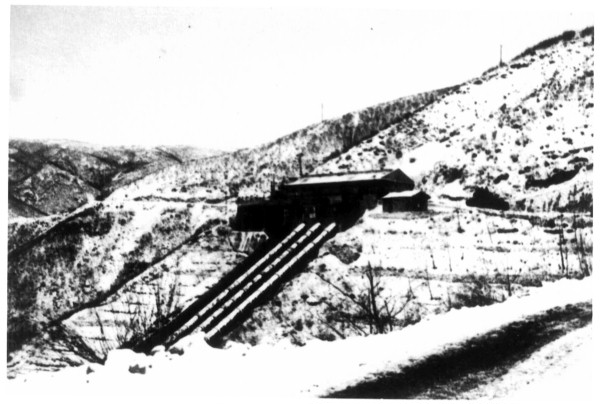
GEN O.P. SMITH'S
AIDE‐MEMOIRE
The Treadway bridge
spans, which had been dropped at Koto‐ri on 7 December, were moved forward
with the advance out of Koto‐ri. At one time during the day the bridge train
was about a mile in advance of the CP of RCT‐7. The ExO of RCT‐7,
feeling the bridge train was too far ahead, directed it to return to the vicinity of
the CP. When this location came under enemy mortar fire, the bridge train was pulled
back about 1 1/2 miles and protected by tanks. By this time it was dark and the
engineers had to wait for the morning of 9 December before they could move to the
bridge site. [The Koto perimeter was receiving harassing small arms fire at this
time while adjustments were being made in the perimeter.]
When the 1/5 Marines moved out of the perimeter at 1200, RCT‐1 used
the 2/5 Marines to reinforce the northern perimeter between D and C, 2/1 Marines. H
3/5 was used to extend the defensive perimeter ot the south. H and I 3/1 Marines
relieved elements of the 185th Negro (C) Bn and C Co 1st Negro Bn in the defensive
perimeter. These engineer units had been holding positions in the perimeter defense
east and southwest of Koto‐ri. The engineers began preparations for
destroying damaged ammunition and all that could not be transported in available
vehicles. RCT‐1 also had to hold back about 3500 civilian refugees who were
crowding the perimeter from the north. [MacArthur's scorched earth
policy‐‐destruction of homes and livelihood ‐‐ resulted
in a major exodus by local civilians. In this terrain and climate the only
possibility for survival was walking to the coastal area of Hungnam.]
On 9 December, preparatory to withdrawing from
Koto‐ri, RCT‐1 relieved the 3/1 Marines in its positions on the
perimeter with the 41st Ind. Commandos, R.M.. the 3/1, at 1530, 9 December, moved
out to occupy Objective B and to relieve the 3/7 Marines on Objective A. The relief
was completed at 1800. The 2/7 Marines had previously been withdrawn from Objective
A to an assembly area nearby. The 1/7 Marines, less the company on Hill 1304
(Objective C), was directed to outpost the MSR between Objective C and the 1/1
Marines in the vicinity of Hill 1081. The 2/7 Marines, less a company with the
regimental train, outposted the MSR between Objective A and Objective C. The 3/7
Marines upon being relieved on Objective A moved to positions on Objective C and
tied in with the company of the 1/7 Marines for the night. [Bridge was being
installed.]
Blown Bridge
Department
of Defense Photo (USMC) 5376.
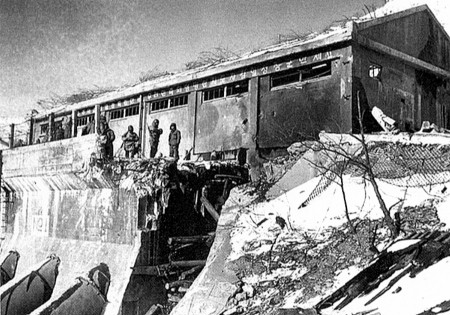
AIDE‐MEMOIRE CONTINUES
...
RCT‐5, less 1/5 on Objective
D, made preparations during the afternoon of 9 December to move out along the MSR
the following day.
With the bridge at the
penstocks, 3 1/2 miles south of Koto‐ri, nearing completion and all
objectives having been occupied, the regimental and division trains were started
down the road out of Koto‐ri. the departure of the trains from Koto‐ri
had been timed so that leading vehicles of the trains would reach the bridge at
approximately the time it was completed. At 1630, 9 December, the trains were moving
through Funchilin Pass enroute to the bridge.
At 2330, 9 December,
the Division Rear CP at Hungnam received OI 27 which directed the Division, upon arrival
at Hungnam, to embark without delay for Pusan.
At
1800, 9 December, the Deputy Chief of Staff of the Division (Colonel Snedeker) opened
the advance CP of the Division at Chinhung‐ni, which was to control the movement
of Division elements from Chinhung‐ni to the south.
Throughout the day of 9 December, civilians refugees continued to gather north
of the perimeter of Koto‐ri. they numbered about 3500. It was necessary to drive
them back by firing over their heads. this was a proper precaution as the CCF were
infiltrating into their ranks.
The perimeter of
Koto‐ri received heavy small arms fire from the southwest during the day but no
attack developed. Much enemy activity was noted to the north, east, and west of the
perimeter and air strikes and artillery fire were placed on observed enemy groups. In
several instances, the artillery employed direct fire on close‐in enemy groups.
BREAKOUT FROM KOTO TO CHINHUNG, 9
December
Click on the map for a
full‐screen image; use your Back button to return to this
text.
Map 13‐1B from the CHOSIN CHRONOLOGY © George A. Rasula, 1992,
2003
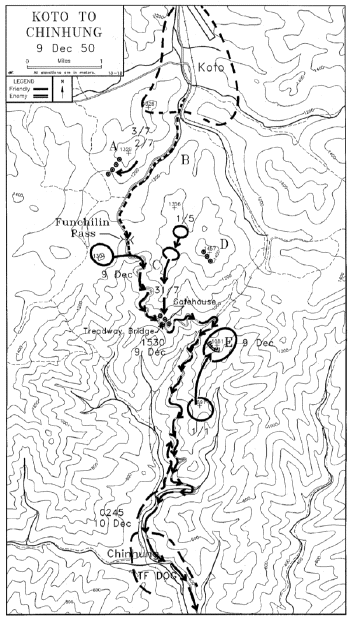
PROVISIONAL BATTALION continues ...
daylight 9 December
Suddenly I heard voices, men talking
in normal tone, no shooting. As I eased back the cover from my face I realized I was
covered with six inches of new snow, the insulation kept me warm and made possible
my sleep. As I eased out of my cozy shelter I saw that the sky was clear, and from
that lofty point above the pass it seemed we could see into eternity, an amazing
sight to look down to see pieces of the road winding down the Funchilin
Pass.
As I rolled up my sleeping bag and tied it to my pack I was
called over to the east side of the perimeter. There off the the east on Hill 1457
stood three Chinese or North Koreans who, by their dress, appeared to be officers.
My soldiers immediately asked permission to take them under fire. When I look at my
map, judging the distance to be more than 500 meters, I asked for someone who had
shot expert the last time on the rifle range. When he came up I told him to get down
in the prone position and adjust his sling and sight just as he would on a range,
and take into consideration the Manchurian wind from the left, then squeeze off one
round. That one shot disturbed the morning calm as it resonated up and down the
valley. Then silence, as the three officers casually turned and walked behind the
hill. We didn't see anyone else from that moment on, convincing me the extreme
cold of the previous night had taken its toll of the ill fed and underdressed
Chinese soldiers.
I then turned to more important matters,
seeking relief for my soldiers before we suffered more casualties. We had suffered
more casualties from cold the previous night than we had suffered all the way from
Hagaru. The wind was picking up as the high was setting in with clear sky and severe
cold, direct sun on the skin being the only warmth one could feel. Since Lt. Col.
Anderson knew nothing of our situation, I had Lt. Escue accompany me as we
backtracked along the ridge line and then took a long diagonal through the deep snow
to the road below. Walking among the column of 7th Marine vehicles it didn't
take long to find the Provisional Battalion command group, with Anderson sitting in
a jeep encased in a GI blanket. As I brief him and received his nods of recognition,
I wondered if I was really making my point. Eventually he said "I'll see
what I can do." At this time I didn't know that units of the 5th Marines
were somewhere in my area, nor was I told. As I turned to leave Corporal Coate, the
S‐3 clerk, presented me with a warm can of C‐rations that he had been
preparing on the engine block, the food warmer of all truck drivers. As I savored
the pork and beans I was reminded that the pancakes at Koto had been my only food
since Hagaru. I looked at the pork and beans as dessert, not knowing, other than a
pocket full of Tootsie Rolls, where the next meal was coming from.
Before I saw Anderson I didn't know what was going on, other than
that the 7th Marines were to our right, to the west on the other side of the road,
and to the east was no‐man's land, the enemy or nothing but snow and
Siberian tigers and bears in hibernation.
I learned that the 1/1 Marines had
been attacking north from Chinhung‐ni, and today would be taking Hill 1081 which
was below and two thousand meters from my mountain. I also learned that the lead
battalion of the 7th Marines was meeting Kitz's Company at the gatehouse and the
bridge repair was about to begin. Things were looking up, but I was still concerned
about my men suffering from frostbite as well as hunger and exhaustion. As the day wore
on the wind‐chill would increase; it always happens when a blue‐sky high
moves in.
I have a vivid memory of that trek down and up the
mountain. It was a Korean cemetery, a group of organized mounds covered with snow, like
those I remember seeing during my earlier tour in South Korea. It was an eerie feeling,
thinking that those mounds were Chinese soldiers who had gone to sleep under their
quilts, now frozen stiff.
It was later that day when a company of the
5th Marines that had been somewhere behind us the previous day finally arrived. It
wasn't a formal relief, just giving up real estate as we moved down the mountain to
another position closer to the gatehouse and the road where Captain Kitz's King
Company had been located. Years later I saw a photo of the blown bridge with as many
Army helmets and parka shells as Marine gear. We enjoyed the new location because it was
protected from the cold wind and most important, it was close to the road with the lead
battalion of the 7th Marines. We'd be the first out.
From then
on it seemed to be a long time waiting for the Engineers to install the Treadway bridge.
Eventually we began the long walk down the switch backs of the Funchilin Pass to
Chinhung‐ni. For the roller coaster enthusiasts it was a thrill to walk down the
twisting and slippery road, although for acrophobia it was often sheer terror, feeling
that a slip would catapult one over a cliff. But that was imagination working because
while the slope below the road was very steep, it was hardly a cliff. I recall on one
occasion when a mess truck suddenly gasped its last breath. We listened as it was pushed
over the side, hearing the pots and pans rattling far down the mountain.
Eventually we met units of Task Force Dog of the 3d Infantry Division in the
area of Chinhung, noting the immense ammunition and ration dumps, supplies that had been
destined for units north of the Pass when the road was cut. I wondered how much would be
destroyed by the Dog Engineers before they pulled out behind the 1MarDiv, knowing the
dumps at Koto as well as Chinhung would be targets of the Korean refugees as well as
Chinese soldiers. We hoped the women and children we had seen would get food and
blankets, although we were sure Chinese rifles would control the distribution.
We sensed warmer weather as we hobbled along on feet trying hard to take the
next step in those uncomfortable shoepacs, footgear not made for long marches. None of
us knew the distance from Hagaru, but we felt the pain. South of Chinhung‐ni we
eventually came to an assembly area of trucks pointed toward Hamhung. When we loaded our
small company and headed south we had to fight to stay awake because of the possibility
of ambushes.
Far to the south we were stopped by an MP and given
directions to the assembly area of the 31st Infantry. There guides led us to a warm
tents with canvas cots and sleeping bags. Many collapsed into fitful
nightmares.
Meanwhile back at Koto aerial evacuation had been taking
place, the last of which were taken out on C‐47s and Navy aircraft, among the
wounded was Major Witte of the Provisional Battalion who had made it that far on the
back of a tank. We learned years later that lieutenants Boyer and Rollin Skilton, both
killed on 6 December during the breakout from Hagaru, were among the 124 marines,
soldiers and British commandos, interred in the mass grave at Koto.
MASS GRAVE CEREMONY AT KOTO
Burial ceremony at the mass grave during the snowstorm on 8 December.
Photo courtesy 41 Commando, Royal Marines.
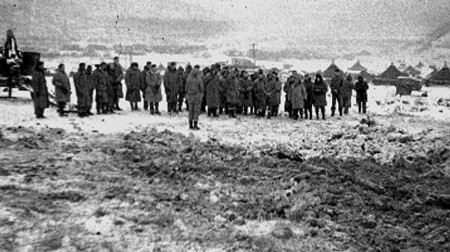
When the Provisional Battalion
31/7 finally closed with the 7th Marines at Hamhung , there were still thousands of
troops and vehicles stretched all the way back to Koto where Puller's 1st
Marines would cover the rear with armor units being last to negotiate the
treacherous Funchilin Pass. Tanks were positioned last in the column because of
possible breakdowns blocking the narrow road. CPT Bob Drake, commander of the 31st
Tank Company, had the foresight to position his lighter tracks ahead of the heavier
Marine tanks, a wise move considering what happened.
Troops of the 41 Commando,
Royal Marines moving through the Funchilin Pass
at a time when
weather conditions varied by the hour, depending on where they were in the
pass.
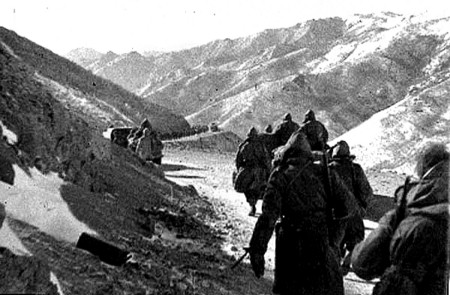
THE FINAL WITHDRAWAL
‐ KOTO TO THE HUNGNAM PERIMETER
Map 14‐1 from the CHOSIN
CHRONOLOGY
Click on the map for a
full‐screen image; use your Back button to return to this
text.
© George A. Rasula 1992, 2003
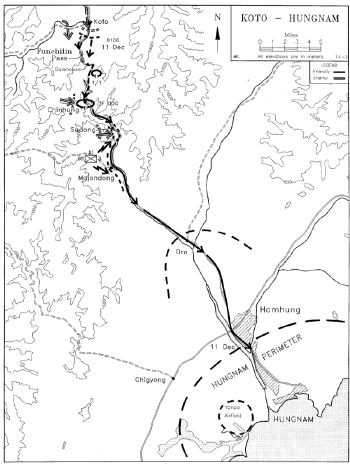
GEN SMITH REPORTS TANK
LOSS
At 2400, 10 December, the tank
column moved out with the Tank Co, 31st Inf leading, followed by B and D 1st Tank
Bn, in that order. The Tank Platoon of the AT Co 5th Marines was attached to D Co.
The Div Recon Co had placed only one platoon at the rear of the tank column, ...
.
Along the icy mountain road south of the pass
the tanks moved slowly with lights on and dismounted crew members acting as guides.
With the high cliff [sic] on the left side and a sharp drop on the right, tank guns
were useless for fire to the flanks. Only the leading and rear tanks could fire to
the front and rear, respectively. ... With frequent stops due to holdups in the
column ahead, the Korean refugees with intermixed CCF troops kept approaching the
last tank in the column.
At about 0100, 11
December, the ninth tank from the tail of the column had a brake lock holding up the
remainder of the column. ...
The tank whose
brake was locked was pushed off the road to a ditch on the left, it being impossible
to push it off the downhill side. The next two tanks behind this one moved around
the abandoned tank. Then the brake on the leading tank became locked. This blocked
the road and, with the enemy exerting heavy pressure, the word was passed to abandon
the immobilized tanks. After this the tank driver managed to release the brake of
the tank having the second brake lock and this tank and one behind it moved out.
However, the remaining tanks had already been abandoned. The covering platoon of the
Div Recon Co suffered fourteen casualties, one officer and eleven men wounded and
two men missing in action, while several casualties were sustained by tank
personnel.
The decision to place the tanks last
in the Division column proved to be a very sound one. It is apparent now that had an
adequate infantry rear guard been provided and had the 2/1 Marines remained on Obj D
until the column had passed, the pressure on the tank column might have been avoided
and at least 6 of the 7 abandoned tanks might well have been brought out. . . . It
is accepted that tanks required infantry protection against close in attack, which
was particularly necessary in this case where the firepower of the tanks was greatly
restricted by the terrain and the road conditions.
THE FINAL WITHDRAWAL
Soon it was a matter of folding in
rear units from their positions on the high ground protecting the MSR, withdrawing
as they continued to watch the rear and flanks. As the tail of the 1MarDiv passed
Chinhung the responsibility for the rear became that of Task Force Dog, and as Dog
withdrew into the protective outpost line of the Hungnam Perimeter they disbanded
and returned to parent units.
The area around Sudong remained a
thorn in the side of both Marines and units of Task Force Dog. Even before the
breakout supply convoys were attacked in that area, later attacking the withdrawing
force. Gen. Smith reports "Just after midnight 10‐11 December the
regimental train of RCT‐1 was ambushed at Sudong by an enemy force ... . In
the resulting action six vehicles were lost and the casualties sustained amounted to
eight killed and 31 wounded. This was a bitter loss, as RCT‐1 had assumed hat
the movement was being covered by protective force." During 11 December similar
but lesser enemy action was experienced by withdrawing units of 1/5 Marines and 1/1
Marines. We regret that the withdrawing units "had assumed" they were
secure in that narrow gorge area south of Chinhung [See topo map]. Security is a
command responsibility that cannot be delegated to units assumed to be in the
area.
Task Force Dog will be a separate story for a future issue
of the Changjin Journal because, as we research its background, we find various
versions of their composition and accomplishments. One book reports they had one
infantry battalion, while another reports five. We continue to search sources.
When the 1MarDiv with attached units
closed into the Hungnam perimeter the mission stated in X Corps OI‐27 was
"on arrival at Hungnam embark without delay for Pusan." This they did, and
fortunately for soldiers of the Provisional Battalion, they too embarked with the
1MarDiv and sailed for Pusan.
END NOTES
This concludes our coverage of Provisional Battalion units during the breakout
from Koto to the Hungnam perimeter. Since this story involved many other units operating
within the same timeframe, we will attempt to cover them in brief segments of future
journals. Noted is the limited coverage of other companies, especially the 32d Company
(King Company) commanded by Captain Kitz, regretting that available resources including
the after‐action report of Captain Kitz contain very little detail about the
phase from Koto to the south. During this writing we have come upon the need for
coverage about the use of armor and artillery during the Chosin campaign. Since very
little is available on these subjects we invited essays on these subjects for use in
future journals.
End CJ 05.01.03
|







